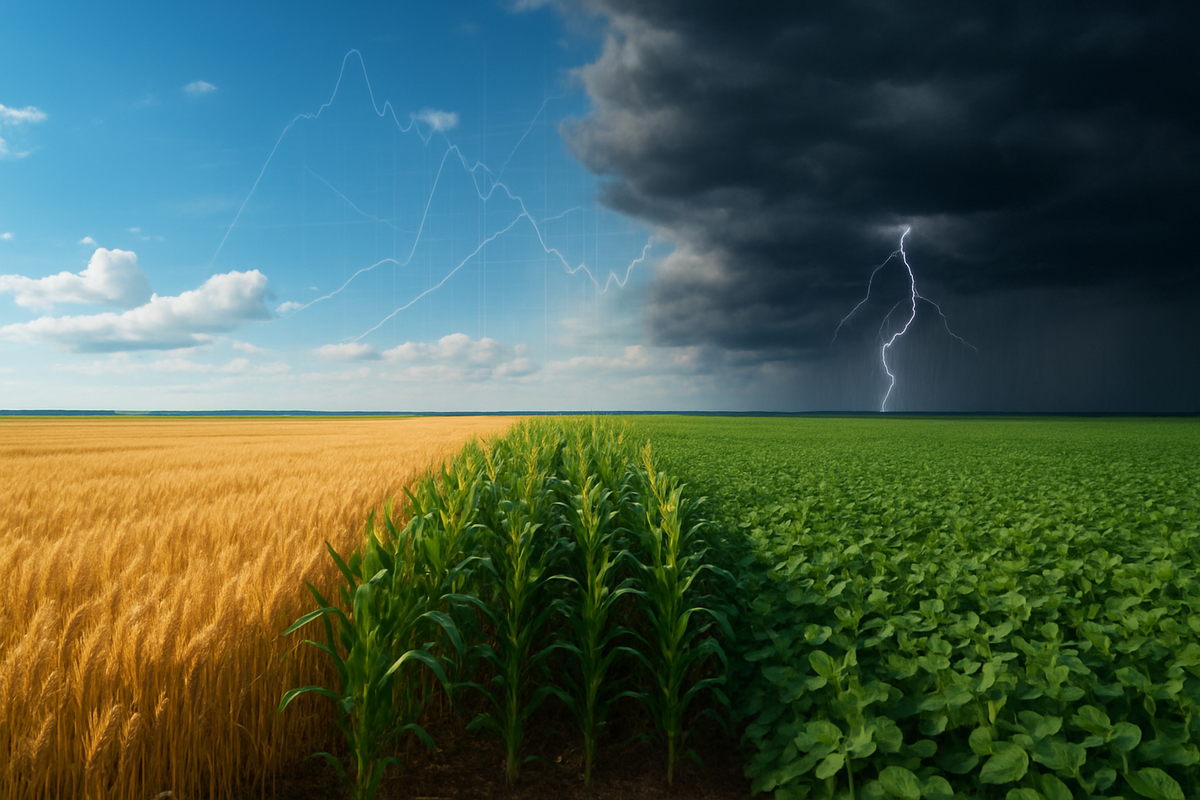Financial News
Global Food Markets Brace for Continued Volatility: A Deep Dive into Agricultural Commodity Price Swings

The global agricultural commodity markets are currently navigating a turbulent landscape, marked by significant price volatility in staple crops such as wheat, corn, and soybeans. This instability, driven by an intricate web of unpredictable weather patterns, shifting global demand dynamics, and evolving international trade policies, poses immediate and long-term implications for food security, inflation, and the profitability of agricultural and food-related industries worldwide. As of November 2025, market participants are grappling with the repercussions of recent climatic events and geopolitical shifts, signaling a period of sustained uncertainty for producers, consumers, and investors alike.
Unpacking the Drivers: Weather, Demand, and Trade Reshape Crop Markets
The current state of agricultural commodity markets is a testament to the powerful, often unpredictable, forces at play. Over the past two years, and continuing into late 2025, specific events have underscored the fragility of global food supply chains.
Weather patterns have been a dominant factor. In 2024 and 2025, prolonged dryness in key wheat-exporting regions like Russia and Argentina significantly curtailed global output. Russia, the world's largest wheat exporter, faced drought conditions in its Krasnodar and Rostov regions, impacting plantings for the 2025 crop. Similarly, the US southern plains experienced delayed harvests due to excessive rains, while Europe, particularly the UK, saw reduced wheat yields in 2024 from winter flooding. These adverse conditions led to sharp price increases, with wheat futures rising by 2.5-4.6% in June 2025 following these reports. For corn, Europe's 2023 drought slashed production by nearly 30%, though the 2024-2025 season saw a slight global decrease from record highs, balanced by a marginal increase in consumption. Brazil, however, faces localized yield declines in 2024-25 due to drought or pest risks. Soybeans have also felt the climatic pinch; the US Midwest's worst drought since 2012 in 2023 cut production by over 100 million bushels, and Argentina's 2023 drought severely reduced crushed soybean output. Conversely, favorable rains in Brazil in late 2024 boosted planting prospects, contributing to a record global production forecast of 421 million tons for 2024/2025, which, alongside Argentina's rebound, has exerted downward pressure on prices.
Global demand fluctuations further complicate the picture. Population growth and evolving dietary habits, particularly the increased consumption of meat and wheat-based diets in developing nations, continually underpin demand for these staples. The expansion of the biofuel sector also plays a significant role; strong demand for US corn is anticipated in 2025, driven by robust ethanol production and exports, while Brazil's rising corn ethanol production is set to impact its export competitiveness. Soybean demand is boosted by the need for alternative proteins and biofuel production, with soybean oil accounting for a significant portion of US biodiesel feedstock. However, an economic slowdown and shrinking pig herds in China, the world's largest soybean importer, have tempered feed demand, creating a nuanced outlook. For 2025/26, global wheat trade is projected to grow by 3.8%, largely due to a 16.4% increase in import demand from Asia, notably China for feed use and Türkiye due to smaller domestic harvests.
Finally, international trade policies have been a significant source of market disruption. Geopolitical tensions and protectionist measures have maintained pressure on prices. Russia, for instance, implemented an export quota of 10.6 million tonnes on wheat from February to June 2025 to manage domestic inflation, while ongoing uncertainties surrounding the Black Sea grain corridor continue to sow unease. A potential US-China trade war in 2025, following the re-election of former US President Donald Trump and his announced intention to impose tariffs on China, is a major concern for corn and soybean markets. Such a conflict could substantially reduce US corn exports and significantly diminish US soybean exports to China, potentially leading to US soybean prices falling nearly $1 per bushel below baseline. This scenario would, however, benefit farmers in Argentina and Brazil, who could see higher prices and expanded export opportunities, with Brazil's soybean exports potentially reaching a record 110 million metric tons in 2025. The European Union's consideration of restricting US soybean imports due to pesticide regulations also adds another layer of complexity to global supply chains.
Corporate Crossroads: Who Wins and Who Loses in a Volatile Market?
The persistent volatility in agricultural commodity prices creates a clear divide between potential winners and losers across various sectors, from farming to food processing and retail. Publicly traded companies with robust risk management strategies, diversified sourcing, and strong financial positions are better equipped to weather the storm, while those with thin margins or concentrated exposure face significant headwinds.
Potential Winners: Agricultural giants involved in grain trading and processing, such as Archer-Daniels-Midland (NYSE: ADM) and Bunge Global SA (NYSE: BG), may find opportunities in price discrepancies and increased trading volumes. Their extensive global networks, logistics capabilities, and hedging strategies allow them to profit from market inefficiencies and supply chain disruptions. Companies that produce agricultural inputs like fertilizers and seeds, such as Corteva, Inc. (NYSE: CTVA) or Nutrien Ltd. (TSX: NTR), could also benefit if high commodity prices incentivize farmers to maximize yields, leading to sustained demand for their products, despite the cost pressures on farmers. Furthermore, futures exchanges and financial institutions offering commodity derivatives stand to gain from increased trading activity as market participants seek to manage risk. Large-scale diversified food manufacturers with strong brands and pricing power, capable of passing on increased raw material costs to consumers, might also mitigate negative impacts.
Potential Losers: Food processors and consumer packaged goods companies with high exposure to specific commodities and limited pricing power are particularly vulnerable. Companies heavily reliant on wheat for baked goods, corn for snacks and sweeteners, or soybeans for oils and animal feed, could see their profit margins squeezed considerably by rising input costs. Smaller, independent farmers, especially those in regions hit by adverse weather, may struggle with reduced yields, increased production costs (e.g., for irrigation or pest control), and limited access to sophisticated hedging tools. Their financial stability could be severely impacted, potentially leading to consolidation in the agricultural sector. Emerging market economies, heavily dependent on imported staple crops, could face increased food inflation, potentially leading to social unrest and macroeconomic instability. Additionally, airlines and transportation companies could face higher fuel costs due to increased demand for biofuels like corn ethanol, impacting their operational expenses.
Broader Implications: A Shifting Global Food Paradigm
The current agricultural commodity price volatility is not an isolated phenomenon but rather a symptom of deeper, interconnected global trends that are reshaping the food industry and beyond. This instability has far-reaching implications, touching upon geopolitical stability, environmental sustainability, and the future of food policy.
Firstly, this volatility underscores the increasing impact of climate change on global food systems. Extreme weather events are becoming more frequent and intense, making agricultural planning and production inherently riskier. This trend necessitates greater investment in climate-resilient agriculture, including drought-resistant crops, improved irrigation techniques, and early warning systems. The ripple effects extend to international relations, as countries with strong agricultural bases gain leverage, while import-dependent nations face heightened food security concerns, potentially leading to protectionist measures or disputes over access to resources. The ongoing negotiations and disruptions related to the Black Sea grain corridor, for instance, highlight how geopolitical tensions directly impact global wheat supply and prices.
Secondly, the event fits into broader industry trends of supply chain re-evaluation and localization. Companies are increasingly looking to diversify their sourcing and build more resilient supply chains to mitigate risks associated with regional disruptions. This could lead to shifts in global trade patterns, with a greater emphasis on regional trade blocs and reduced reliance on single-source suppliers. Regulatory bodies are also likely to scrutinize agricultural markets more closely, potentially implementing policies aimed at stabilizing prices, supporting domestic production, or establishing strategic food reserves. Historically, periods of high food price volatility, such as those seen in 2008 and 2011, have often led to increased government intervention and a push for greater transparency in commodity markets.
Lastly, the interplay between food and energy markets is becoming more pronounced. The expanding biofuel sector, particularly for corn ethanol and soybean biodiesel, creates direct competition for land and resources with food production. This dynamic can amplify price swings, as energy policies and oil prices directly influence demand for agricultural commodities. The drive for sustainable energy, while crucial, must be carefully balanced with global food security needs to avoid unintended consequences for vulnerable populations.
The Road Ahead: Navigating Uncertainty and Seizing Opportunities
Looking ahead, the agricultural commodity markets are poised for continued dynamism, demanding strategic foresight and adaptive responses from all stakeholders. Both short-term adjustments and long-term transformations will be necessary to navigate this evolving landscape.
In the short term, market participants should anticipate continued price fluctuations driven by immediate weather forecasts, updates on crop conditions, and any new developments in international trade relations. Investors will closely watch inventory levels, particularly global wheat stocks which are forecast to decline to their lowest since 2021/22 despite projected production rebounds. Companies will likely focus on optimizing inventory management, enhancing hedging strategies, and diversifying their supply chains to buffer against sudden price shocks. Governments may consider tactical interventions, such as adjusting export quotas or import tariffs, to stabilize domestic food prices and ensure adequate supply. The potential for a renewed US-China trade war in 2025 remains a critical short-term uncertainty, with significant implications for corn and soybean flows.
In the long term, the need for sustainable and resilient agricultural systems will become paramount. This includes accelerated investment in agricultural research and development to produce higher-yielding, climate-resilient crop varieties. The expansion of precision agriculture technologies, utilizing data analytics and automation, will be crucial for optimizing resource use and improving yield predictability. Market opportunities may emerge for companies specializing in agricultural technology (AgriTech), sustainable farming solutions, and alternative protein sources that can reduce reliance on traditional commodity crops. Furthermore, the increasing demand for biofuels will continue to shape the agricultural landscape, requiring careful policy coordination between energy and food sectors to ensure both sustainability and food security. Strategic pivots might include deeper integration of vertical farming, controlled environment agriculture, and localized food production initiatives to reduce dependence on long, vulnerable supply chains.
Potential scenarios range from a gradual stabilization of prices as global production adapts to new realities and trade policies become more predictable, to prolonged periods of heightened volatility if climate change impacts intensify and geopolitical tensions escalate. The most likely outcome is a continuation of periodic price spikes and dips, necessitating a proactive approach to risk management and innovation across the agricultural value chain.
Wrap-Up: A New Era of Agricultural Market Dynamics
The current period of agricultural commodity price volatility marks a significant juncture for global food markets. The confluence of extreme weather events, shifting global demand patterns, and evolving international trade policies has created an environment where price swings in staple crops like wheat, corn, and soybeans are not merely cyclical but indicative of deeper structural changes. The key takeaway is that the era of relatively stable agricultural commodity prices may be behind us, replaced by a new normal of heightened uncertainty.
Moving forward, the market will be characterized by an increased premium on agility, resilience, and strategic foresight. Companies that invest in diversified sourcing, robust risk management, and innovative agricultural technologies will be best positioned to thrive. Governments will face the ongoing challenge of balancing domestic food security with international trade obligations and climate change mitigation efforts. The lasting impact of this volatility will likely be a re-evaluation of global food systems, fostering a push towards more sustainable, localized, and resilient agricultural practices.
Investors should closely watch several key indicators in the coming months: global weather patterns, particularly in major agricultural producing regions; updates on international trade negotiations and policy shifts, especially concerning US-China relations and the Black Sea grain corridor; and the trajectory of global economic growth, which influences demand for both food and biofuels. Furthermore, monitoring advancements in AgriTech and the adoption of climate-resilient farming practices will provide insights into the long-term trajectory of agricultural supply and prices. The imperative is clear: adapt or face the significant challenges posed by a perpetually dynamic and unpredictable global agricultural market.
This content is intended for informational purposes only and is not financial advice
More News
View More




Recent Quotes
View MoreQuotes delayed at least 20 minutes.
By accessing this page, you agree to the Privacy Policy and Terms Of Service.



